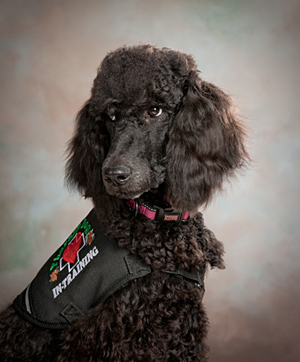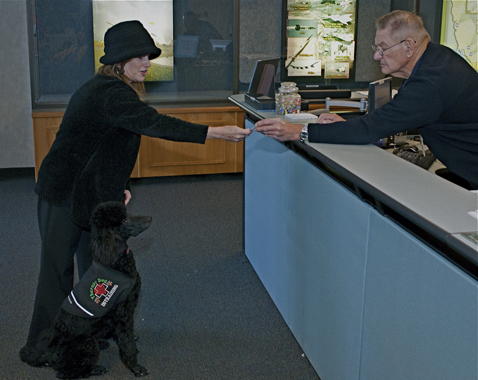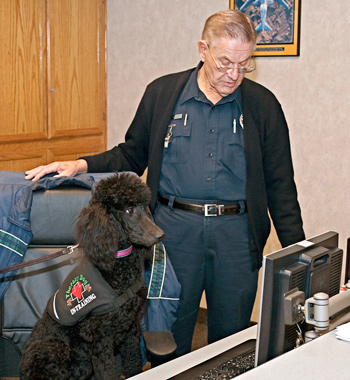There’s a new face in Dryden’s Employee Assistance Program office – a furry one. EAP manager Kathleen Christian has begun introducing a standard poodle named Ella into her work counseling employees and their families, and decided to share the experience in a blog. Through Ella’s perspective and her own, in coming weeks Dr. Christian will share the story of Ella the Therapy Dog’s arrival, training and impact at the center.
The use of animals in therapy is a growing practice. Wide-ranging clinical studies of its effectiveness have verified significant and positive results. Trained therapy animals like Ella are turning up in hospitals, nursing homes, counseling centers and elsewhere – anyplace they can offer human colleagues the comfort of a friendly nuzzle and some warm companionship. Follow Ella’s story here and help welcome her to Dryden!

Ella, NASA Dryden therapy dog on the right, plays with her canine friend Jack
On My Way Home
10/8/10 – I could feel that this day would be different. No breakfast. Then a bath. I don’t like them. I don’t like the grooming table, the brush, the scissors. Everything moves too fast. Two women came in a car. I liked them because I got to get down off the table and play. The women talked for a long time. I think they were talking about me. After awhile She put a rope on me. She took me outside and put me in the car. She sat with me in the back seat, and I liked that. She knew how to hug me the way standard poodles like me like to be hugged. It made me feel better. She said that someday soon we would go to work and that we would help people. I have no idea what that means. I don’t think dogs help people, and I think She may be confused about that.
After a long time we get out of the car. She says this place is home. I play with another dog, named Jack. He is kind to me and doesn’t growl or bite. Jack is showing me how to run really fast and jump down to the grass below, run some more and jump up to the path above. There are many new things to see and do and eat at home. Lots of trees, grass, stairs, flowers and sticks. She says not to eat the flowers. She doesn’t want me to eat the rocks, either. The horses scare me, but the cats don’t. I can hear chickens, but I can’t see them. All the other animals are on the other side of the fence. Sometimes I bark at them. She says not to. I do it anyway.
She takes me in the car almost every day. One day we walk down a street where there are a lot of cars and sounds. There are some ladies with red hats on coming out of a place that smells good. We walk toward them. The first lady talks very, very loud in a high voice that makes me nervous. The lady walks fast over to me, stares at me and her hands come fast toward my face. There is another lady behind her making barking noises like a small dog. I sit next to Her; I want to run, but She doesn’t run, so I try hard to be still. She looks down and I can tell She is uncomfortable, too. She tells the lady I’m a puppy and maybe the lady needs to leave me alone today. We walk away. I’m glad we are leaving. She tells me she is sorry, that was the wrong place to go.
I never knew there was this kind of world. I feel tired. She lets me sleep as much as I want to and lets me sleep at night on her bed. I really like that. She says when I go to work I am going to meet a lot more people and that I might help some of them. I’m not sure how that will happen. I don’t think she does, either.
Kathy’s note: Ella seems to be making a great transition. Although I have raised many dogs, I am a little bit surprised at her demeanor with people. She is definitely not a wiggly, jumping-on-everyone puppy. I think the best word to use for her is “contemplative.” Unfortunately, there is a fine line between contemplative and afraid. At such a young age, this training will ask a lot from her. Her ability to trust me implicitly will be a critical element, and I realize that the energy I project when greeting people will make a big difference. I am looking forward to her first day at work on Oct. 18. I expect surprises and challenges for both of us. As a therapy dog at NASA, there will be many situations she will have to handle. She will need to learn to deal effectively with employees under a tremendous amount of stress, not to mention all varieties of aircraft, associated equipment and facilities and all the smells, sights and sounds that accompany them. The adventure begins!
Next: Ella’s first day at work.


 This is the end of my fourth week at work. There are so many new things I get to see and do. The people aren’t so anxious, and they don’t lean down so fast when they see me. She seems calmer, too. The people know my name. I like to hear it down the hallways and when they come into Her office. When we walk into the big buildings, I hear my name come from out of doorways, or from far down the hall. Sometimes we stop and talk to the people. They touch me and I like that a lot.
This is the end of my fourth week at work. There are so many new things I get to see and do. The people aren’t so anxious, and they don’t lean down so fast when they see me. She seems calmer, too. The people know my name. I like to hear it down the hallways and when they come into Her office. When we walk into the big buildings, I hear my name come from out of doorways, or from far down the hall. Sometimes we stop and talk to the people. They touch me and I like that a lot.  Ella’s first weeks have been exciting. She has blossomed from being reserved and rather overwhelmed to being overtly happy and welcoming to most of the people she meets. In fact, it is now time to start the next phase of training. She is very good on the leash, but now she is starting to want to walk ahead and take the lead. I understand that not everyone wants to touch her, and so she has to learn to wait to be told by me that she can greet someone. I am struggling with her initiative. Like working with a shy or uncertain child just coming out of their shell, there is a point at which some discipline must be applied. Timing will be very important. I think I’ll wait for a few more weeks; I don’t want to start too soon lest she become discouraged.
Ella’s first weeks have been exciting. She has blossomed from being reserved and rather overwhelmed to being overtly happy and welcoming to most of the people she meets. In fact, it is now time to start the next phase of training. She is very good on the leash, but now she is starting to want to walk ahead and take the lead. I understand that not everyone wants to touch her, and so she has to learn to wait to be told by me that she can greet someone. I am struggling with her initiative. Like working with a shy or uncertain child just coming out of their shell, there is a point at which some discipline must be applied. Timing will be very important. I think I’ll wait for a few more weeks; I don’t want to start too soon lest she become discouraged.